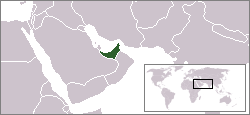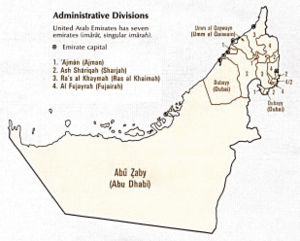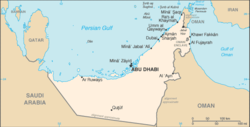United Arab Emirates
2007 Schools Wikipedia Selection. Related subjects: Countries; Middle Eastern Countries
| الإمارات العربيّة المتّحدة Al-Imārāt al-ʿArabiyyah al-Muttaḥidah United Arab Emirates |
|||||
|
|||||
| Motto: none | |||||
| Anthem: Ishy Bilady | |||||
| Capital | Abu Dhabi |
||||
|---|---|---|---|---|---|
| Largest city | Dubai | ||||
| Official languages | Arabic | ||||
| Government | Constitutional monarchy | ||||
| - President | Khalifa bin Zayed Al Nahayan | ||||
| - Prime Minister | M. bin Rashid Al Maktoum | ||||
| Establishment | December 2, 1971 | ||||
| Area | |||||
| - Total | 83,600 km² ( 116th) 32,278 sq mi |
||||
| - Water (%) | negligible | ||||
| Population | |||||
| - 2005 estimate | 4,496,000 ( 116th) | ||||
| - 2005 census | 4,104,695 | ||||
| - Density | 54/km² ( 143rd) 139/sq mi |
||||
| GDP ( PPP) | 2006 estimate | ||||
| - Total | $111.3 billion ( 59th) | ||||
| - Per capita | $27,957 ( 23rd) | ||||
| HDI (2004) | 0.839 (high) ( 49th) | ||||
| Currency | Dirham ( AED) |
||||
| Time zone | GMT ( UTC+4) | ||||
| Internet TLD | .ae | ||||
| Calling code | +971 | ||||
The United Arab Emirates (also the UAE or the Emirates) is a Middle Eastern country situated in the southeast of the Arabian Peninsula in Southwest Asia on the Persian Gulf, comprising seven emirates: Abu Dhabi, Ajmān, Dubai, Fujairah, Ras al-Khaimah, Sharjah, and Umm al-Quwain. Before 1971, they were known as the Trucial States or Trucial Oman, in reference of a nineteenth-century truce between Britain and several Arab Sheikhs. It borders Oman and Saudi Arabia. The country is rich in oil.
History
The seven Trucial Sheikdom States of the Persian Gulf coast granted the United Kingdom control of their defence and foreign affairs in nineteenth-century treaties. In 1971, six of these states — Abu Dhabi, Ajman, Fujairah, Sharjah, Dubai, and Umm al-Qaiwain — merged to form the United Arab Emirates. They were joined in 1972 by Ras Al Khaimah.
Politics
The Supreme Council consists of the individual rulers of the seven emirates. The President and Vice-President are elected by the Supreme Council every five years. Although unofficial, the Presidency is de facto hereditary to the Al-Nahyan clan of Abu Dhabi and the Premiership is hereditary to the Al-Maktoum clan of Dubai. The Supreme Council also elects the Council of Ministers, while an appointed forty-member Federal National Council, drawn from all the emirates, reviews proposed laws. There is a federal court system; all emirates except Dubai and Ras al-Khaimah have joined the federal system; all emirates have both secular and Islamic law for civil, criminal, and high courts.
Sheikh Zayed bin Sultan Al Nahyan was the union's president from the nation's founding until his death on 2 November 2004. His son, Khalifa bin Zayed Al Nahayan was elected, by the Federal Supreme Council, president the next day.
Human rights
It is a common practice for employers in the UAE to retain employees' passports for the duration of the employment contract to prevent expatriate employees from changing jobs. This is an illegal practice, but it is almost never investigated, let alone punished by the government. Further, there are court rulings that government departments are also holding their employees' passports. On termination of an employment contract, most categories of expatriates used to be automatically banned from obtaining a work permit in the country for six months and a no entry stamp would be stamped on their passports. However this has recently been revoked (2005) and it requires a petition on the employers part for this to occur. This has created considerable new labour movement in the market since it was implemented. There has also been an increase in labour agitation as a result.
The United States Department of State has cited widespread instances of blue collar labor abuse in the general context of the United Arab Emirates.
The government has been criticized by the human rights agency Human Rights Watch for its inaction in addressing the discrimination against Asian workers in the emirates. Salary structures and treatment based on nationality, sex, age, and race rather than on qualification are common.
According to Ansar Burney Trust (ABT), an illegal sex industry thrives in the emirates, especially in Dubai. This complements the tourism and hospitality industry, a major part of Dubai's economy. A 2004 HBO documentary accuses the UAE of illegally using child jockeys in camel racing, where they are also subjected to physical and sexual abuse. Antislavery.org has documented similar allegations. The ABT, which was featured heavily in the HBO documentary, announced that in 2005 the government of the UAE began actively enforcing a ban on child camel jockeys, and that the issue "may finally be resolved". This has happened and will start with the new camel racing season this year (2006).
The UAE's human rights record, particularly in relation to migrant workers, was widely criticized during the trials of Sarah Balabagan in 1995.
A website is campaigning to pressure the government of the UAE into signing up to International Labour Organization core conventions on freedom of association (see ). Strikes and unions are currently banned in the UAE and many laborers are virtual prisoners, having paid huge agents' fees in order to obtain jobs and visas.
Migrant workers
Migrant workers, either unskilled or skilled, comprise a large portion of UAE's workforce. A 2003 Human Rights Watch report estimates up to 90 percent of the country's 1.7 million workers are migrants . These migrants, drawn to wages often more than they could make in their home countries, have helped UAE's endless construction projects proceed rapidly. However, unlike many other countries, these foreign workers (also known as expatriates) do not have a claim to UAE citizenship and thus cannot be naturalized. This is generally only possible through marriage to a UAE or GCC citizen. People from neighboring Arab countries or Iran who entered the country illegally during the 1950's and 60's, however, are full UAE citizens because of the fact that poor border controls existed at that time.
Migrant workers in UAE face many challenges. As mentioned above, disparities in salaries and treatment occur for different races, with Arabs and Westerners getting better pay than their Asian or non-Arab counterparts. Even among Asians there are disparities. For example, a worker from South Asia, China or Philippines may receive lower pay and worse treatment than one from Japan or Singapore.
There are mixed reports on prison conditions; in general, prisons in both Abu Dhabi and Dubai meet international standards. There have been various reports that prisons in remote and rural areas are of lower standards. Al-Wathba prison is a prison complex located outside Abu Dhabi city in close proximity to the Abu Dhabi International Airport. It is one of the main prisons in the UAE and houses inmates waiting execution and deportation and also those who have been handed life sentences. It consists of living quarters, detention centre and execution grounds. Executions (a rarity) are carried out by firing squad.
Economy
United Arab Emirates is the richest country in the Muslim world . Though current GDP per capita contracted by 42% in the 1980s, successful diversification helped register positive growth of 48% in the 1990s.
Geography
The UAE lies in Southwest Asia, bordering the Gulf of Oman and the Persian Gulf, between Oman and Saudi Arabia. It is a flat, barren coastal plain merging into rolling sand dunes of vast desert wasteland; with mountains in the east. Desert land covers over 90% of the country . Its strategic location along southern approaches to the Strait of Hormuz makes it a vital transit point for world crude oil.
The border demarcation treaties of 1974 and 1977 between the United Arab Emirates and Saudi Arabia were never made public. Therefore the exact border of the two countries is only known to their governments.
Exclaves and enclaves
There is an Omani enclave inside UAE territory, known as Wadi Madha. It is located halfway between the Musandam peninsula and the rest of Oman, on the Dubai- Hatta road in the Emirate of Sharjah. It covers approximately 75 km² (29 mi²) and the boundary was settled in 1969. The north-east corner of Madha is closest to the Khor Fakkan- Fujairah road, barely 10 m (33 ft) away. Within the enclave is a UAE exclave called Nahwa, also belonging to the Emirate of Sharjah. It is about 8 km (5 mi) on a dirt track west of the town of New Madha. It consists of about forty houses with its own clinic and telephone exchange .
Transportation
Airlines history
The national airline of Abu Dhabi was formerly Gulf Air, operated jointly with Bahrain and Oman. On September 13, 2005, Abu Dhabi announced that they were withdrawing from Gulf Air to concentrate on Etihad Airways, designated as the new national carrier of the UAE, established in November 2003.
In 1985, Dubai established its airline Emirates, which is now one of the fastest growing airlines in the world .
Demographics
UAE has one of the most diverse populations in the Middle East. Since the mid- 1980s, people from all across South Asia have settled in the UAE. UAE's better living standards and high economic opportunities have made it an attractive destination for Indians and Pakistanis. In 2006, there were approximately 1.2 million Indian nationals and 300,000 Pakistani nationals in the UAE, making them the largest expatriate community in the oil-rich nation.
|
11% |
|
The most populated city is Dubai, with approximately 1.2 million people. Other major cities include Abu Dhabi, Al Ain, Sharjah, and Fujairah.
About 88% of the population of the United Arab Emirates is urban. The remaining live in tiny towns scattered throughout the country or many of the desert oilfield camps.
Culture and religion
Rooted in Islamic culture, the UAE has strong ties with the rest of the Arab world and Islamic world. The government is committed to preserving traditional forms of art and culture, primarily through the Abu Dhabi Cultural Foundation. New sports are becoming popular alongside traditional camel racing. Examples of these new sports include golf, with two European Tour events in the country (the Dubai Desert Classic and the Abu Dhabi Golf Championship) and the world's richest horse race, the Dubai World Cup, held annually in March . Many churches are present in the UAE, as in several other Muslim countries that are tolerant of other religions. Due to the fact the many Asians have made UAE their second home, there is a variety of Asian restaurants and cultural centres. There also exist a few European centres and schools.
The first known manuscript in UAE is Al jawaher wal la'li.
Holidays
| Date | English | Arabic | |
|---|---|---|---|
| 1 January | New Year's Day | رأس السنة الميلادية | |
| variable | Day of the Sacrifice | Eid ul-Adha | عيد الأضحى |
| variable | Islamic New Year | Ra's Al Sana Al Hijria | رأس السنة الهجرية |
| 6 August | Accession of H.H. Sheikh Zayed bin Sultan-al Nahyan | Eid julous Al-Sheikh Zayed bin Sultan al-Nahyan | عيد جلوس الشيخ زايد بن سلطان آل نهيان |
| variable | The Night Journey | Isra'a wa al-Miraj | الإسراء و المعراج |
| 2 December | National Day | Al-Eid Al Watani | العيد الوطني |
| variable | End of Ramadan | Eid ul-Fitr | عيد الفطر |




